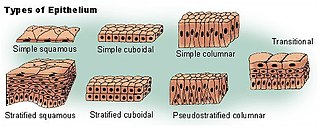Epithelium
tissue lining the surfaces of organs in animals From Wikipedia, the free encyclopedia
Epithelium (plural: epithelia) is one of the four main types of tissue in the body of animals. It is made up of one or more layers of cells.

The outermost layer of the skin is a special type of epithelium. It has an important function: it forms a mechanical defence against infection: see innate immunity.
Epithelia are found on the surface of organs and many other parts of the body. One main function of epithelia is moving fluids into or out of an organ or body part. It also protects organs and carries sense organs.
There are many different types of epithelium that do different things in the body, including the excretory system. The epithelium covers blood vessels and hollow organs such as the stomach and kidneys. All glands are made from epithelial cells. In some areas, the epithelium secretes sweat, oil, or mucus.
The functions of epithelial cells include secretion, selective absorption, protection, transcellular transport, and sensing. Epithelial layers have no blood vessels: they get oxygen and nourishment from the underlying connective tissue, through their basement membrane.[1]
Bibliography
Other websites
Wikiwand - on
Seamless Wikipedia browsing. On steroids.
